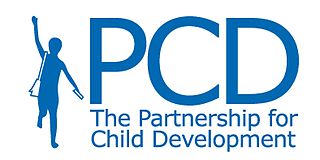Related Research Articles

Hand washing, also known as hand hygiene, is the act of cleaning one's hands with soap or handwash and water to remove viruses/bacteria/microorganisms, dirt, grease, and other harmful or unwanted substances stuck to the hands. Drying of the washed hands is part of the process as wet and moist hands are more easily recontaminated. If soap and water are unavailable, hand sanitizer that is at least 60% (v/v) alcohol in water can be used as long as hands are not visibly excessively dirty or greasy. Hand hygiene is central to preventing the spread of infectious diseases in home and everyday life settings.
Behavior change, in context of public health, refers to efforts put in place to change people's personal habits and attitudes, to prevent disease. Behavior change in public health can take place at several levels and is known as social and behavior change (SBC). More and more, efforts focus on prevention of disease to save healthcare care costs. This is particularly important in low and middle income countries, where supply side health interventions have come under increased scrutiny because of the cost.

Global health is the health of populations in a worldwide context; it has been defined as "the area of study, research, and practice that places a priority on improving health and achieving equity in health for all people worldwide". Problems that transcend national borders or have a global political and economic impact are often emphasized. Thus, global health is about worldwide health improvement, reduction of disparities, and protection against global threats that disregard national borders, including the most common causes of human death and years of life lost from a global perspective.

The Partnership for Child Development (PCD) is a research and technical assistance group based at Imperial College London that seeks to improve health and nutrition in school-age children and youth in low-income countries, thereby improving their education outcomes. PCD was formed in 1992 at the University of Oxford to bridge gaps between academia, funding bodies and the education and health sectors in low-income countries.
The Expanded Program on Immunization is a World Health Organization program with the goal to make vaccines available to all children.

The Institute for Health Metrics and Evaluation (IHME) is a national and international public health agency and research institute working in the area of global health statistics and impact evaluation, located at the University of Washington in Seattle. IHME is headed by Christopher J.L. Murray, a physician, health economist, and global health researcher, and professor at the University of Washington Department of Global Health, which is part of the School of Medicine. IHME conducts research and trains scientists, policymakers, and the public in health metrics concepts, methods, and tools. Its mission includes judging the effectiveness and efficacy of health initiatives and national health systems. IHME also trains students at the post-baccalaureate and post-graduate levels.
Dean Tecumseh Jamison is an American economist and leader in the study of global health. He is currently Senior Fellow in Global Health Sciences at University of California, San Francisco and an Emeritus Professor of Global Health at the University of Washington in Seattle. He has published in health economics, global health, education economics, and decision theory.
Prabhat Jha is an Indian-Canadian epidemiologist currently working in the field of global health.

The Economics of Land Degradation (ELD) Initiative is a global initiative which aims to increase awareness of the benefits of sustainable land management and economic consequences of land degradation.
This page is a timeline of global health, including major conferences, interventions, cures, and crises.
In global health, priority-setting is a term used for the process and strategy of deciding which health interventions to carry out. Priority-setting can be conducted at the disease level, the overall strategy level, research level, or other levels.
WHO-CHOICE is an initiative started by the World Health Organization in 1998 to help countries choose their healthcare priorities. It is an example of priority-setting in global health. It was one of the earliest projects to perform sectoral cost-effectiveness analyses on a global scale. Findings from WHO-CHOICE have shaped the World Health Report of 2002, been published in the British Medical Journal in 2012, and been cited by charity evaluators and academics alongside DCP2 and the Copenhagen Consensus.

Mexico has sought to ensure food security through its history. Yet, despite various efforts, Mexico continues to lack national food and nutrition strategies that secure food security for the people. As a large country of more than 100 million people, planning and executing social policies are complex tasks. Although Mexico has been expanding its food and nutrition programs that have been expected, and to some degree, have contributed to increases in health and nutrition, food security, particularly as it relates to obesity and malnutrition, still remains a relevant public health problem. Although food availability is not the issue, severe deficiencies in the accessibility of food contribute to insecurity.
Olive Chifefe Kobusingye is a Ugandan consultant trauma surgeon, emergency surgeon, accident injury epidemiologist and academic, who serves as a Senior Research Fellow at both Makerere University School of Public Health and the Institute for Social and Health Sciences of the University of South Africa. She heads the Trauma, Injury, & Disability (TRIAD) Project at Makerere University School of Public Health, where she coordinates the TRIAD graduate courses.
Adnan A. Hyder is Senior Associate Dean for Research and Professor of Global Health at the George Washington University Milken Institute School of Public Health.

Lee Alan Wallis is the South African Head of Emergency Medicine for the Western Cape Government, Professor and Head of the Division of Emergency Medicine at the University of Cape Town and Stellenbosch University, and the founding President of the African Federation for Emergency Medicine.
Charles N. Mock is a professor of Global Health, Surgery, and Epidemiology at the University of Washington and expert on injury prevention and trauma care in low- and middle-income countries.
Nita Madhav is an epidemiologist and risk modeler who was CEO of Metabiota from 2019 - 2022.

Mark Richard Cullen is a physician, scholar, and population health scientist known for his work in occupational medicine. As a professor at Yale and later Stanford University, his research focused on the social, environmental, behavioral and bio-medical determinants of morbidity and mortality in adults, with special emphasis on the role of workplace’in such matters.
Margie Peden is a South African public health researcher and injury prevention expert who serves as Head of the Global Injury Programme at the George Institute, University of Oxford, and co-director of the WHO Collaborating Centre on Injury Prevention and Trauma Care. Formerly, she was the lead coordinator of the Unintentional Injury Prevention (UIP) Unit at the World Health Organization for 17 years.
References
- ↑ "About DCPP". Disease Control Priorities Project. Archived from the original on June 6, 2012. Retrieved 2012-12-18.
- 1 2 3 "About the Project" . Retrieved March 30, 2016.
- ↑ "Partner organizations". Disease Control Priorities Project. Archived from the original on March 21, 2013. Retrieved 2012-12-18.
- ↑ "New Initiative Will Assess Disease Control Priorities In Developing Countries". Gates Foundation. 2002-09-03. Retrieved 2012-12-18.
- ↑ "Collaborators". Disease Control Priorities 3. Retrieved June 8, 2016.
- ↑ Jamison, Dean T.; Mosley, W. Henry; Measham, Anthony R.; Bobadilla, José Luis, eds. (1993). Disease Control Priorities in Developing Countries. Oxford University Press.
- ↑ "Disease Control Priorities in Developing Countries (2nd Edition)". Disease Control Priorities Project. Archived from the original on January 23, 2013. Retrieved 2012-12-18.
- ↑ Jamison, Dean T.; Breman, Joel G.; Measham, Anthony R.; Alleyne, George; Claeson, Mariam; Evans, David B.; Jha, Prabhat; Mills, Anne; Musgrove, Philip, eds. (2006). Disease Control Priorities in Developing Countries, Second Edition. Disease Control Priorities Project (mirrored on the World Bank website). doi:10.1596/978-0-8213-6179-5. ISBN 978-0-8213-6179-5 . Retrieved 2012-12-18.
- ↑ Jamison, D. T.; Breman, J. G.; Measham, A. R.; Alleyne, G.; Claeson, M.; Evans, D. B.; Jha, P.; Mills, A.; Musgrove, P. (2006). Disease Control Priorities in Developing Countries, 2nd edition. Disease Control Priorities Project (mirrored on the NCBI website). ISBN 9780821361795. PMID 21250309 . Retrieved 2012-12-18.
- 1 2 "Disease Control Priorities in Developing Countries Second Edition – Front Matter" (PDF).
- ↑ Disease Control Priorities: Improving Health and Reducing Poverty (PDF). Disease Control Priorities, Third Edition. Vol. 9. 2018.
- ↑ "About Disease Control Priorities, Third Edition". DCPP. Retrieved May 23, 2016.
- ↑ "DCP3 Companion Publication on NCDs in Latin America Now Available | DCP3". dcp-3.org. June 14, 2016. Archived from the original on 2016-06-17. Retrieved 2020-12-24.
- ↑ "Launch of DCP3 Companion Publication on Child Development and Education | DCP3". dcp-3.org. March 23, 2018. Archived from the original on 2018-05-05. Retrieved 2020-12-24.
- ↑ "Launch of the Latest Companion Edition to DCP3 on School Feeding | DCP3". dcp-3.org. October 30, 2018. Archived from the original on 2019-03-10. Retrieved 2020-12-24.
- ↑ Alexander (2011-09-29). "Errors in DCP2 cost-effectiveness estimate for deworming". The GiveWell Blog. Retrieved 2020-12-24.